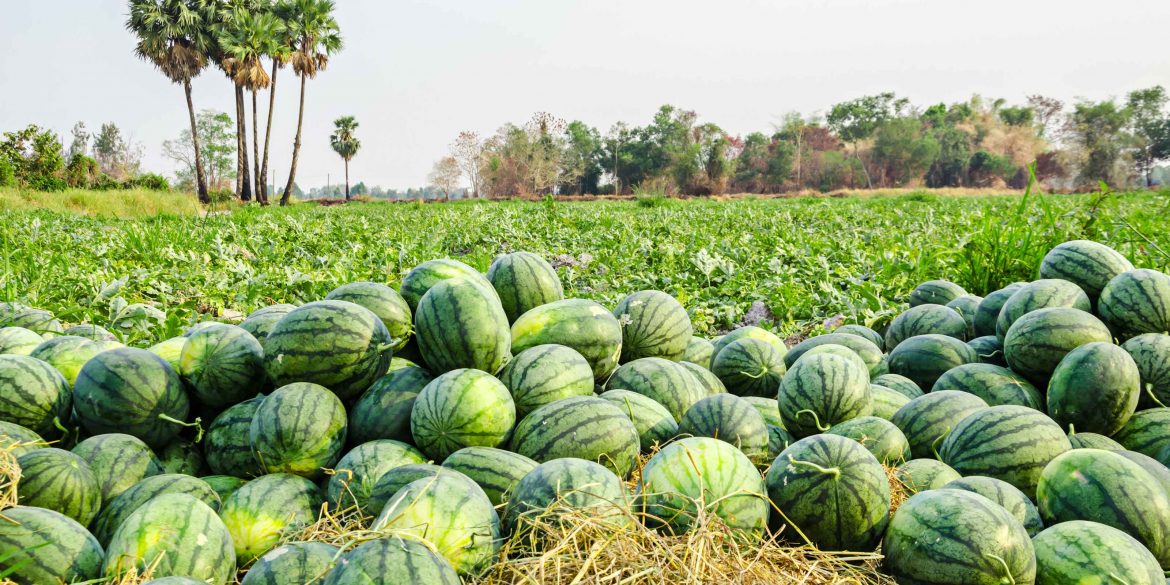DID YOU KNOW? CUCURBITS PRODUCE THE LARGEST FRUITS IN THE PLANT KINGDOM!!
Watermelon is a flowering plant species of the Cucurbitaceous family. Its cucurbit family members include squash, pumpkin, cucumber, gourd and cantaloupe.

- Most cucurbits are monoecious or and romonoecious
- Have an extensive root system with depth of rooting depending on species
- Stems are trailing with laterals branching from the nodes
- Some vines of cucurbits may reach length of 12-15m
- Leaves maybe simple but most are 3 to 5 lobes with considerable variation in shape, size and depth of lobes
Seedless watermelons:
- Sterile triploid hybrids that produce fruits with few or not true seeds (not viable or of good quality)

Seedless watermelons actually are not totally seedless. They contain white, edible seed structures like those in a cucumber. And under certain growing conditions a few hard, black seed coats will develop.
PHYSIOLOGY
- A warm season crop that requires a long growing season ( up to about 4 months)
- Thrives in humid or dry arid conditions but high humidity or rains increase foliar diseases occur and may be problematic
- Warm dry weather during fruit development results in optimum quality that is good for market
- Optimum temperature for germination 25-35oC
- Below 20oC germination is slow while below 15oC, germination is poor.
- If seeds are exposed to low temperature after radicle emergence, the seed is injured and nothing will emerge
CROP ESTABLISHMENT
Cultivar types can be:
1. Fruit shape- long vs round, shipping types have thick rind
2. Fruit colour- grey, green (light and dark) striped
3. Flesh colour- red, pink or yellow
4. Seeded or seedless
Where to Plant Watermelons
- Plant watermelons in full sun.
SOIL AND SEEDING
- Loose, well-drained, but moisture-retentive soil rich in organic matter.
- Add aged compost and aged manure or a commercial organic planting mix to the planting bed before planting. Turn the soil to 12 inches (30cm) deep. Melons prefer a soil pH of 6.0 to 6.8.
- Plant watermelons on hills or mounds or on raised rows. Solar heat hitting the soil on a mound or raised row will keep plants and roots warm.
- Create a mound 6 to 12 inches (15-30cm) high and 5 feet (1.5m) across.
- If planting in ground-level beds, warm the soil in advance of planting by laying black plastic sheeting on the bed two weeks before planting.
- Watermelons are directly seeded with 2-3 seeds planted at each station,
Thinning is then done to leave 2 plants
- Plant spacing of 2.4 – 3m between rows and 2.4m between plants within the row
Transplanting: possible though not common
FERTILIZERS
- 70-110kg/ha N, 30-55kg/ha P, and K
- Apply half the fertilizer 6cm to the side and 6cm below the seeds.
- The remainder should be applied as a top dressing shortly after thinning at the 4-5 true leaf stage
COMPOUND C OR L as basal fertilizer and AMMONIUM NITRATE as top dressing
Once the plant begins flowering, however, switch to feeding the watermelon a phosphorus and potassium based fertilizer. Watermelons require a lot of potassium and phosphorus for optimal melon production.
Companion Plants for Watermelons
- Plant watermelons with corn, radish, beans, and nasturtiums
WATER REQUIREMENTS
- A minimum of 380mm of water is required to grow water melons
- Watermelons are 95 percent water. They require plentiful regular, even watering for quick growing.
- Give watermelons 1 to 2 inches (2.5.-5cm) of water every week (1 inch equals 16 gallons/60.5 litres.)

Please Note:
- Shallow mechanical cultivation and hand hoeing are needed to control weeds before plants have vined.
- Pruning roots and vines with cultivating equipment slows melon development and reduces yield.
HARVESTING IS BY HAND
- 75-130 days from planting
- Fruit is harvested when the flesh is sweet but not overripe
- When overripe, the flesh becomes mealy and stringy
- It is difficult to determine maturity- if harvested too early they will be low in sugar and flavour and once harvested the sugar content will not increase
WATERMELON PESTS
- Aphids and spotted and striped cucumber beetles will attack melons.
- Hose away aphids with a blast of water or pinch out infested foliage.
- Hand-pick and destroy cucumber beetles promptly; they can transmit cucumber bacterial wilt to melons. You can also control cucumber beetles by spraying insecticidal soap, neem oil, or dusting with kaolin.
WATERMELON DISEASES
Watermelons are susceptible to anthracnose, Alternaria leaf spot, bacterial wilt, and powdery and downy mildew.
Planting disease-resistant varieties when they are available and maintaining the general cleanliness and health of your garden will help cut down the incidence of disease.
Do not handle the vines when they are wet; this can spread fungal diseases.
If a plant does become infected remove it before it can spread the disease to healthy plants.
- Bacterial wilt which is spread by cucumber beetles can cause watermelon plants to suddenly wilt and die just as they begin to produce fruit. Control cucumber beetles as soon as they appear.
- Anthracnose is a soil-borne fungal disease that can cause leaf spots, leaf drop, wilting, and sometimes death. Keep the garden clean and plant disease-resistant varieties. Remove diseased plants from the garden immediately.
- Powdery mildew and other fungal diseases can be prevented and slowed by spray-misting plants with compost tea or a solution of 1-part skim milk and 9-parts water.

Common watermelon varieties are
- Charleston Gray
- Crimson Sweet
- Sugar Baby.
However, some seed houses are coming up with different hybrid varieties like Star 9905 from Charter Seeds and Kito from Prime Seed.
HERE ARE THE TOP 8 HEALTH BENEFITS OF EATING WATERMELON.
- Helps You Hydrate
- Contains Compounds That Help Prevent Cancer
- Improve Heart Health
- Lower Inflammation and Oxidative Stress
- Help Prevent Macular Degeneration
- Help Relieve Muscle Soreness








This is a great resource website for entrepreneurs.
Very informative and thoroughly researched and enjoyable.